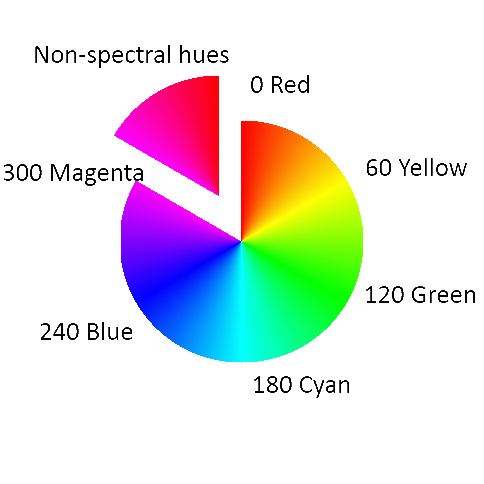The Rainbow and those missing colors
No discussion about color would be complete without a reference to the rainbow.
We delight in the appearance of a rainbow when we stand with our back to the sun on a showery day and look towards the showers. It has to be early in the morning or late in the afternoon as the sun has to be fairly low in the sky to generate a rainbow. I'm not going into the physics of how it's generated except to say that it's caused by light being refracted and reflected inside the spherical raindrops. Nor will I explore the really fascinating phenomenon of the double rainbow that appears under ideal conditions. What I'm interested in is how the colors in the rainbow compare to those that we can generate in print, TVs and computer screens.
|
The rainbow fades in from the outside, from grey through red, yellow, green, blue and purple to a lighter grey below as you can see in this nice photo I harvested from the web. These colors pretty well match those we saw in the spectrum displayed earlier:
The major difference is that the prism spectrum fades in from black, not grey like the rainbow, and the rainbow's colors are washed-out compared to the prism. |

|
But where's the continuity of colors that we see in the color wheel? Well, the answer is that those bluey-pink colors between Magenta (300°) and Red (360 °) on the color wheel just don't exist in the spectrum and are therefore known as "non-spectral hues". We can manufacture these in print and on the TV screen, but they just don't exist in the pure spectrum. |
 |
It's also interesting to note the way that the colors emerge in the spectrum. From the black depths, the magenta merges into purples, blue and then through to red which then fades back into black. But note how the red lingers, not changing hue but just getting darker.
I did some analysis of the spectrum image in the HSV color space and plotted the results in the spreadsheet below. To do the analysis, I used a "color picker" tool from the paint.net drawing package and plotted the H, S and V values at around 40 points along the spectral image.

The most striking feature I discovered was that the Hue value decreased steadily and linearly from the Magenta end, around 280° at the low end of 420 nm, to pure Red, 0° at 650nm while the image was still bright. It then remained at 0° until the image faded at around 720nm. So instead of tracing a smooth path, it was "L-shaped" with a significant discontinuity at 650 nm. when it gets to Red.
Whilst the Saturation remained at 100% for the whole range, the Value followed a fairly smooth increase from a low of about 30% to a high of 100% in the yellow band where it started a gentle decline to 70% at the 650nm point where the hue bottomed out at 0° (Red), and then steadily declined to 20% where the colors were indistinguishable from black.
So we find that the colors in the spectrum are really very different from the those in the color wheel:
- There is a significant absence of colors from color wheel (Magenta through to Red) and
- The hues in the spectrum exhibit a noticable discontinuity when they reach Red while the hue in the color wheel increase steadily with no discontinuity.